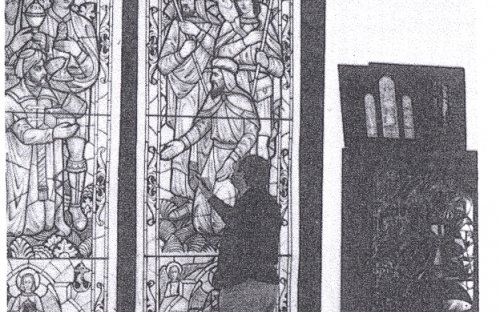Industry of the Month, as featured in "Extension In Action"
Written by Mary Elizabeth Dunbar, January 1978
Published by Cooperative Extension Association of Cattaraugus County
The concept of fusing art, history, religion and science into a career life style has not been forgotten by Dr. Rudolph R. Sandon who works quietly at his studio near Little Valley, creating artwork that shines with light-interpreting life, history and religion through translucent panes of stained-glass windows.
Dr. Sandon is a Master Artist, who holds Doctorate Degrees in Theology, Art and Architecture, speaks five languages, is a veteran of four wars, a master interpreter of the Bible, and who finds fulfillment in his work with stained glass. He states, "the making of stained glass is as exacting today as it was in the 12th century."
The Sandon tradition of artistry in stained glass started in 1736 in Munich, Germany with Galeazzo Sandon. For more than 200 years, through six generations of the family, special craft secrets have passed from father to son. A native of the South Tyrolian Alps, he has been plying his trade since he was 10 years old. His father, Arturo, was the artist-designer of the only stained glass Rose window in St. Peter's Cathedral at Rome. Working with his late father and others, he has helped design and create windows for European monarchs and various churches, mosques and synagogues throughout the world.
Dr. Sandon was a youth of 18, studying at the University of Padua, when he was called into the Italian Infantry and served that country in the Ethiopian War, Spanish Civil War, Finnish Russian War, and was commissioned Captain in the Alpine troops during World War II. He was discharged from the Italian Army as a Colonel. He had been a member of the Italian Ski Teams in the Olympics of 1936 at Garmisch-Partenkirchen and in 1940 at Helsinki. He did graduate work to obtain his doctorate in 1945 and came to the U.S. in 1946 where he became a U.S. citizen over 30 years ago.
In Cleveland, Ohio he entered business for himself and founded the Sandon Studios with stained glass windows as his specialty. He worked mainly for various churches and his artistry is evident in approximately 400 churches, both small and large and in almost every state in America. He generally has five or six employees on his staff. Until a year ago November, the Studio was more recently located in Painesville, Ohio. A frequent visitor to Western New York ski slopes, he decided to move to this area and relocate his business.
Dr. Sandon started working with facet glass in the 1950's (a new medium in the field of stained glass), and has worked at this art rather steadily through the years to develop this special technique. Faceting is a process of cutting and chipping 1 inch thick slabs of colored glass, then composing them in a window design, with an epoxy mortar. The artist says facet glass technique gives the art form a "contemporary feeling".
According to Dr. Sandon, there are only about 19 other studios comparable to his, left in the world. "We don't guess here - we discuss, debate and research to get things done properly". Since different groups worship differently, representation of religious figures in window compositions must be done carefully.
In creation of a stained glass window, the first step is a sketch or a design just as it will appear when finished. The next step is to enlarge the design to a full scale, black and white drawing known as a cartoon. Each heavy-cut line on the cartoon represents the leading of the finished window - each enclosed white segment, a piece of glass. When completed, a tracing is made of it and each of the pieces of glass which eventually will make up the window are drawn in pattern form and designated by color.
Selection of glass is important. Pot metal glass made in small European shops is imported. Color is not merely on the surface but all the way through, giving hues of gemlike enduring quality. The glass is cut with ordinary glass cutters. When all the pieces have been cut, they are assembled in their respective patterns and after all tracing black print is applied where necessary, for emphasis, they are fitted together and attached with beeswax on a large sheet of clear glass (easel), so at length, the entire window may be held up to the light and the effects of colors and design studied.
The next step is to paint the glass with a brownish pigment (stain), which when scratched through with special brushes and instruments, give shading and highlights effects, when fired in a kiln, will fuse with the glass surface.
The final step in the making of a window is fitting the glass into lead strips, the same shape as those used in medieval times. In cross-section their form is that of the letter H, the two grooves holding the edge of the glass. The lead is soft and pliable and easily worked. One by one, the artist fits the pieces into it, binding everything into an interlocking web of glass and lead. It is necessary, however, to go over it, soldering together the lead joins and cementing the strips to the surface of the glass for weather-proofing.
The completed window is then ready to be installed. Then it will be set into place and anchored securely into the frames.

